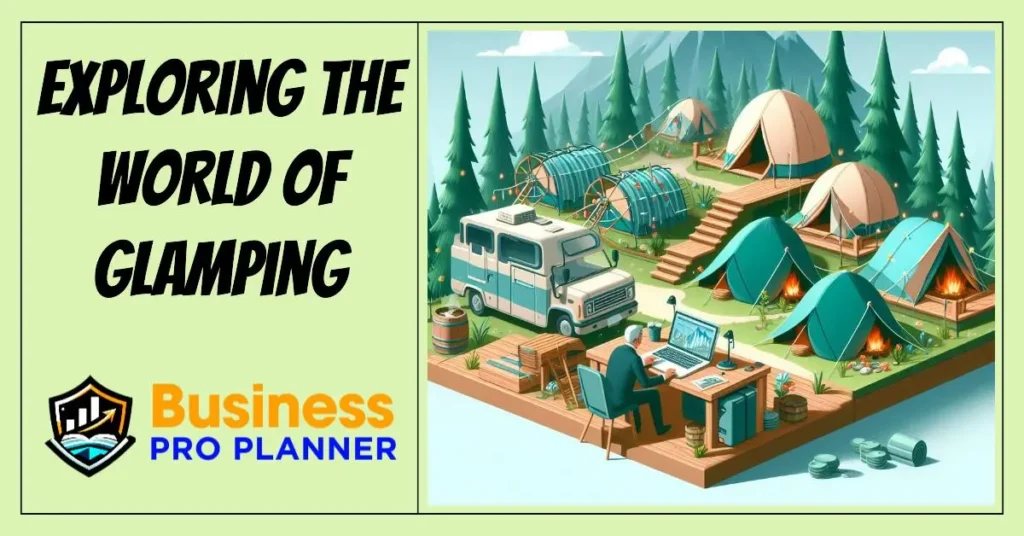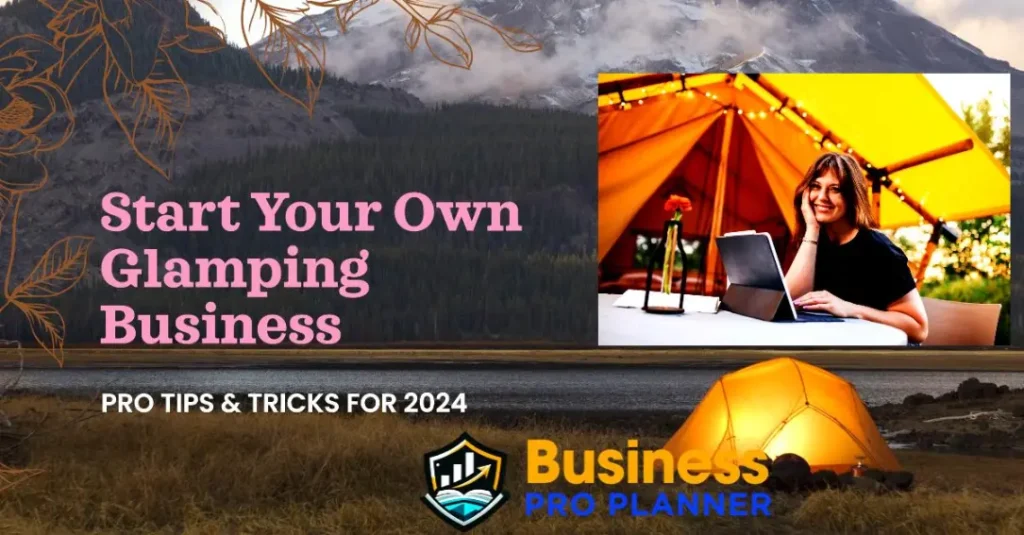Glamping, or luxury camping, has become an increasingly popular vacation option in recent years. With the global glamping market size projected to reach $6.8 billion by 2027, now can be a great time to start a glamping business and take advantage of this growing trend.
Key Takeaways
- Research your local glamping market and choose the right glamping structures for your area. Consider bell tents, pods, or luxury tents.
- Create a thorough glamping business plan covering operations, marketing, financials, and risk factors.
- Obtain necessary permits and licenses, and ensure your glamping site follows regulations.
- Promote your new glamping business through online listings, search engine optimization, and social media.
- Focus on delivering a high-end, amenity-filled glamping experience to attract and retain guests.
If you have access to appealing land or are interested in acquiring land for your glamping site, and enjoy hospitality, starting a glamping business can allow you to tap into the profitable glamping market.
Understanding the Glamping Industry

Basic Concept of Glamping
Glamping, short for glamorous camping, is a popular trend that combines luxury amenities and accommodations with the rustic appeal of outdoor camping. Unlike traditional camping, glamping focuses on providing hotel-like comforts like real beds, flush toilets, private bathrooms, and electrical outlets while immersed in nature.
Glamping structures range from furnished safari tents and yurts to wooden cottages and fully outfitted RVs. The interior décor is high-end with premium furniture, chandeliers, king-sized beds, and modern kitchens. Some glamping sites also offer spa services, butler services, gourmet food, and planned recreation activities. This luxurious twist on camping caters to travelers seeking to experience the great outdoors with minimal roughness or inconvenience.
The term glamping has been around since the early 2000s but has gained significant popularity over the last decade. It appeals to those who want to enjoy camping in a picturesque natural setting but prefer more comfort and amenities than a traditional tent site provides. Glamping allows you to sleep surrounded by fresh air and scenery without sacrificing luxury.
Glamping Industry Size and Future Perception
The glamping industry has seen tremendous growth worldwide, especially in North America and Europe. According to a 2019 report from Arizton, the global glamping market was valued at approximately $2.3 billion and is projected to reach $6.8 billion by 2027. This represents an annual growth rate of over 14% as this trend gains momentum.
North America is considered the fastest growing glamping market with the United States and Canada leading the expansion. The 2019 North American Glamping Report indicated the region contained over 40% of glamping sites globally. Glamping is especially popular among millennials and couples looking for unique outdoor recreation.
The United Kingdom, France, and Germany are major markets in Europe and also demonstrate the increasing demand for glamping holidays. Australia and New Zealand likewise show high interest in luxury camping options. As more people become aware of glamping and seek meaningful travel experiences, the industry is forecasted to continue on a strong growth curve.
Trends and Challenges
Some top trends propelling the rise of glamping include:
- Adventurous millennials and Gen X travelers seeking new destinations and trips focused on wellness or sustainability.
- Increased interest in staycations instead of international vacations.
- The desire for family trips and reunions in natural settings that accommodate all generations.
- Pet-friendly options for travelers unwilling to leave pets behind.
- Boutique venues provide exclusive glamping experiences.
However, there are challenges facing the growing glamping industry:
- Development and operating costs can be high, requiring significant startup investment.
- Zoning laws in some areas restrict this type of tourist accommodation.
- Risk of damage to tents and site during extreme weather.
- Staffing issues are common in the hospitality and tourism sectors.
- Ensuring eco-friendly and low-impact practices.
Different Types of Glamping
Numerous structures and site setups qualify as glamping, allowing business owners to choose the style that fits their location and brand.
Tent Glamping
- Safari Tents – Classic canvas bell tents on raised wooden platforms with electricity and upgraded bedding.
- Bubble Tents – Clear inflatable domes that allow stargazing from the bed.
- Eco Tents – Large tents made from sustainable materials like bamboo with minimal environmental impact.
Cabin Glamping
- Treehouse Cabins – Elevated structures high in trees offer a whimsical feel.
- Cottage Cabins – Permanent small cottages provide a charming, rustic ambiance.
- Geodesic Domes – Structures made of a network of triangles formed from short struts. Stable in windy conditions.
Alternative Glamping
- Yurts – Circular structures with canvas walls and domed roofs based on traditional design.
- Tipis – Tall cone-shaped tents made of poles covered with sheets of canvas. Center fire pit.
- Pods – Small standalone units often with unique shapes, walls, and roofs built from varied materials.
RV Glamping
- Vintage Airstream Trailers – Retro RVs renovated with modern interiors.
- Luxury Motorhomes – Large, high-end recreational vehicles with premium amenities.
- Restored Towable Campers – Updated interiors in classic trailers.
Potential Benefits and Drawbacks
Advantages:
- Capitalize on growing consumer interest in nature, adventure, and unique lodging.
- Tap into rising demand for comfortable, upscale outdoor recreation options.
- Cater to preferences for local, authentic travel experiences and wellness vacations.
- Take advantage of the ability to set premium rates for one-of-a-kind accommodations.
- Expand customer base as glamping appeals to diverse demographics including couples, families, and groups.
- Lower overhead compared to traditional hotels since located on inexpensive land.
- Draw repeat business by providing exceptional service and amenities in natural settings.
Disadvantages:
- Significant startup costs for land purchase/lease, permits and fees, luxury tents and furnishings, utilities, and insurance.
- Potential zoning issues and local restrictions on this type of property use.
- Logistical issues related to remote locations like accessibility, lack of staff housing, and weather risks.
- Need to provide high-end posh experiences to compete and justify premium rates.
- Risk of low occupancy and reduced revenue during off-season periods.
- Ongoing maintenance and operating expenses are comparable to hotels.
Initial Cost of Starting Glamping Business
The cost of starting a glamping business can vary greatly depending on size, structures offered, and location. However, expect substantial startup costs including:
- Land purchase, lease fees, or rent ranging from $50,000 to over $500,000.
- Glamping units like luxury tents or cabins at $10,000 to $60,000 each.
- Infrastructure costs for access roads, electricity, sewage, and utilities can range from $100,000 to $500,000+.
- Business filing and licensing fees are around $5,000.
- Insurance policies covering $1 million or more for property, liability, worker’s comp.
- Website development, marketing, staffing, and pre-opening costs of $40,000+.
- Contingency budget of 10-20% for unexpected expenses.
According to Travel and Hospitality Tech, most owners spend $200,000 to $2 million to start a small glamping resort. Mid-range glamping businesses require $1 million to $5 million in initial investment. The substantial upfront costs underscore the importance of detailed business planning and financing when launching a glamping enterprise.
Key Steps Need to be Taken to Start a Glamping Business
Here is an in-depth guide on key steps to take when starting your own glamping business.

Choose the Right Location
One of the first and most critical decisions will be choosing the location for your glamping site. Prime factors to consider include:
- Natural Beauty: Glamping destinations can charge premium pricing when located near lakes, mountains, beaches, or other attractive natural settings. Proximity to state or national parks can also draw interest.
- Accessibility: While remote wilderness can work for some glamping businesses, many operate closer to major highways and cities so guests can easily access amenities during their stay.
- Local Attractions: Nearby attractions like wineries, golf courses, hiking trails, or historic sites help provide activities to keep glamping guests engaged.
- Competing Sites: Research whether other glamping businesses already operate in the area to determine if there is room in the local market. Avoid oversaturation.
- Regulations: Ensure zoning allows for this type of hospitality business and adhere to any regulations around waste management, safety protocols, noise limits, etc.
Research Different Glamping Structures
Once you’ve selected a promising location, the next step is deciding what type of glamping structures to offer. Some top options include:
- Bell Tents: Spacious circular tents featuring modern and stylish interiors. Often around 20 feet wide.
- Pods: Small standalone temporary structures like yurts, teepees, or cubby cabins. Offer a unique glamping experience.
- Safari Tents: Luxury tents range from simple tents to lavish permanent tents with electricity and plumbing.
- Treehouses: Elevated accommodations nestled in trees for a whimsical glamping option. Need trees suitable for supporting a treehouse.
- Airstreams: Vintage trailers can provide retro flair. Require renovations to create comfortable guest stays.
Consider your target audience, climate, and capacity goals when selecting the best structures for your new glamping site.
Create a Detailed Business Plan
Every new business needs a business plan to map out objectives and tactics. Key elements to cover in your glamping business plan include:
- Executive Summary: High-level overview of your glamping business plans and projections.
- Company Description: Information on your glamping site like location details and style of structures.
- Market Analysis: Research the target glamping demographic and competitors.
- Operations Plan: How you will construct, maintain, and manage the glamping units and site. Staffing needs and responsibilities.
- Marketing Plan: Strategies for promoting your glamping destination through advertising, social media, SEO, and partnerships.
- Financial Plan: Expected startup costs, operating expenses, and sales projections. Funding needs and sources.
- Risk Analysis: Potential issues like seasonality, regulations, competition, and liability along with mitigation approaches.
Having a well-developed business plan is crucial for securing funding, mapping out operating processes, and preparing contingency plans.
Obtain Necessary Permits and Licenses
There are various legal requirements involved with opening a hospitality business like a glamping site. Be sure to research and obtain:
- Business licenses and tax IDs
- Zoning permits
- Lodging or hotel permits
- Food service permits if offering dining
- Insurance policies like liability insurance
- Liquor licenses if serving alcohol
Relevant state, county, and municipal departments can advise on required licenses and permits for your area and type of business.
Adhere to Regulations
In addition to obtaining permits, there are ongoing regulations that glamping businesses must follow:
- Safety codes: Ensure structures comply with fire safety, electrical, and construction standards.
- Waste management: Proper septic or sewage systems must be in place along with trash and recycling collection.
- Accessibility: ADA-compliant accommodations may need to be offered.
- Zoning: Only operate approved activities within designated parameters like noise limits and guest capacity.
- Hospitality: Adhere to laws around privacy, non-discrimination, taxes, and guest rights.
Stay current on all hospitality, lodging, outdoor recreation, and local business regulations so your glamping site remains fully compliant.
Market and Promote Your Glamping Business
Once your glamping structures are in place, robust marketing and promotional efforts are vital for generating interest and bookings. Tactics can include:
- Create an eye-catching website highlighting your accommodations and amenities. Optimize for glamping-related keywords.
- Establish social media accounts to promote availability, share reviews and photos, and interact with potential guests.
- Register your glamping site on listing platforms like Glamping Hub, HipCamp, and Airbnb.
- Run local print, radio, or television ads showcasing your ideal location.
- Partner with local hotels, event venues, and tourist attractions to arrange referral partnerships and package deals.
- Offer special seasonal rates and promotions to boost occupancy during slower booking periods.
Ongoing marketing is essential for establishing your glamping site as a leading lodging option for vacationers in your region.
Deliver Top-Notch Guest Experiences
While the accommodations are the draw, it is the overall guest experience that generates buzz and repeat visits for a glamping business. Go beyond just the overnight stay by:
- Giving guests a warm welcome upon arrival and farewell upon departure. Provide area recommendations.
- Offering fun on-site activities like yoga classes, craft workshops, live music, or storytelling around a communal campfire.
- Allowing guests to reserve add-on services like massages, trail rides, or guided stargazing sessions.
- Providing daily housekeeping and turn-down service.
- Ensuring 24/7 assistance from knowledgeable staff.
- Serving artisanal breakfasts showcasing local ingredients and cuisine.
Finding ways to delight guests can lead to glowing online reviews, expanded referral networks, and increased reservations.

Conclusion
Starting a thriving glamping business allows you to capitalize on the growing glamping trend while operating a rewarding hospitality enterprise. By choosing an ideal site, selecting the perfect structures, creating a solid business plan, obtaining necessary permits, adhering to regulations, executing marketing strategies, and providing exceptional service, your glamping destination can become a top local attraction. With the tourism sector expanding, now is an opportune time to start planning this exciting new business venture.

